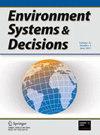ISSN:
print: 2194-5403
on-line: 2194-5411
on-line: 2194-5411
研究领域:
Environmental Science-Environmental Science (all)
Gold OA文章占比:
0.00%
原创研究文献占比:
0.00%
SCI收录类型:
Scopus (CiteScore)
期刊介绍英文:
Aims and Scope:
Emerging challenges to infrastructure systems, industry, government, and society exhibit complexity, interconnectedness, uncertainties, and a variety of stakeholder perspectives. The Springer journal Environment, Systems & Decisions addresses diverse interests and perspectives of infrastructure owners, engineers, environmental professionals, regulators, policy makers, scholars, educators, and managers through technical articles, editorials, and review articles. The journal advances theory, methodology, and applications to address these challenges from a systems view, emphasizing connectedness of humans, machines, and the environment. Methods that arise in the physical, social, and information sciences and engineering are integrated or coordinated.
Submitted manuscripts should address interrelated social, technological, environmental, and economic systems with attention to performance, risk, costs, sustainability, and resilience. The ESD journal thus provides a catalyst for research and innovation in cross-disciplinary and transdisciplinary methods, featuring decision analysis, systems engineering, risk assessment and risk management, resilience analysis, policy analysis, data science, and communication. Manuscripts in a variety of application domains (engineering, military, environment, ecology, health, regulation, policy, technologies, logistics, manufacturing, etc.) are invited, particularly to feature problems and solutions that cross domains and envision future systems and processes.
Peer Review Policy:
Manuscripts are reviewed with due respect for the author''s confidentiality. At the same time, reviewers also have rights to confidentiality, which are respected by the editors. Environment Systems and Decisions uses a single-blind peer-review system, where the reviewers are aware of the names and affiliations of the authors, but the reviewer reports provided to authors are anonymous. Single-blind peer review is a traditional model of peer review that many reviewers are comfortable with, and the process supports a dispassionate critique of a manuscript. The editors ensure both the authors and the reviewers that the manuscripts sent for review are privileged communications and are the private property of the author.
CiteScore:
| CiteScore | SJR | SNIP | CiteScore排名 |
|---|---|---|---|
| 9.0 | 0.820 | 1.110 | 学科 排名 百分位 大类:Environmental Science 小类:General Environmental Science 35 / 233 85% |
发文信息
历年影响因子
历年发表
| 2012年 | 3 |
|---|---|
| 2013年 | 59 |
| 2014年 | 45 |
| 2015年 | 49 |
| 2016年 | 40 |
| 2017年 | 49 |
| 2018年 | 45 |
| 2019年 | 38 |
| 2020年 | 37 |
| 2021年 | 48 |
| 2022年 | 42 |
投稿信息
出版周期:
4 issues per year
初审时长:
5 days
出版商:
Springer Nature
Environment Systems and Decisions - 最新文献
A rheological model analog for assessing the resilience of socio-technical systems across sectors
Pub Date : 2024-07-15 DOI: 10.1007/s10669-024-09983-w Alexander Stolz, Jet Hoe Tang, Stefan G. Fischer, Kai FischerAnalysing the drivers for sustainable public procurement
Pub Date : 2024-07-09 DOI: 10.1007/s10669-024-09985-8 Felippe Santos, Rodrigo Lozano, María Barreiro-GenEngineering and public health: converging disciplines for resilient solutions
Pub Date : 2024-06-14 DOI: 10.1007/s10669-024-09981-y Christopher L. Cummings, Emily M. Wells, Benjamin D. Trump
免责声明:
本页显示期刊或杂志信息,仅供参考学习,不是任何期刊杂志官网,不涉及出版事务,特此申明。如需出版一切事务需要用户自己向出版商联系核实。若本页展示内容有任何问题,请联系我们,邮箱:info@booksci.cn,我们会认真核实处理。
本页显示期刊或杂志信息,仅供参考学习,不是任何期刊杂志官网,不涉及出版事务,特此申明。如需出版一切事务需要用户自己向出版商联系核实。若本页展示内容有任何问题,请联系我们,邮箱:info@booksci.cn,我们会认真核实处理。





